Application of Three-Repetition Tests Scheme to Improve Integrated Circuits Test Quality to Near-Zero Defect
Abstract
:1. Introduction
2. Errors in the Semiconductor Chip Manufacturing Process and Test Process
2.1. Estimation and Calculation of the Formula for Manufacturing Yield (Ym)
2.2. Estimation of the Formula for Test Yield (Ym)
3. IC Test Yield and Product Quality Are Strongly Affected by the ATE Accuracy
4. A New Scheme for Three-Repetition Tests
Selecting the Number of Valid Retests Determines the Company’s Profitability
5. The Use of the TRTS in IRDS 2021 Data
5.1. Method for Testing Near-Zero Defect Chips
5.2. Estimate the Company’s Increased Profits from a Cost-Benefit Perspective
5.3. The Triple Test Scheme Has Advantages and Future Development Prospects
6. Conclusions
Author Contributions
Funding
Institutional Review Board Statement
Informed Consent Statement
Data Availability Statement
Conflicts of Interest
References
- AEC-Q001-REV-C; Guidelines for Part Average Testing. Automotive Electronics Council. 2003, pp. 3–7. Available online: http://www.aecouncil.com/Documents/AEC_Q001_Rev_C.pdf (accessed on 28 February 2022).
- AEC-Q004; Zero Defects Guideline. Automotive Electronics Council. 2006. Available online: https://www.aecouncil.com/Documents/AEC_Q004_DRAFT.pdf (accessed on 28 February 2022).
- Chang, P.; Huang, Y.K. Intelligent Method for Retesting a Wafer; Teslence Technology Co., Ltd.: Taipei, Taiwan, 2021; Available online: https://www.swtest.org/swtw_library/2019proc/PDF/S02_02_Chang_SWTest_2019.pdf (accessed on 28 February 2022).
- Cheng, K.C.C.; Chen, L.L.Y.; Li, J.W.; Li, K.S.M.; Tsai, N.C.Y.; Wang, S.J.; Huang, A.Y.A.; Chou, L.; Lee, C.S.; Chen, J.E.; et al. Machine Learning-Based Detection Method for Wafer Test Induced Defects. IEEE Trans. Semicond. Manuf. 2021, 34, 161–167. [Google Scholar] [CrossRef]
- Horng, S.C.; Lin, S.Y.; Cheng, M.H.; Yang, F.Y.; Liu, C.H.; Lee, W.Y.; Tsai, C.H. Reducing the overkills and retests in wafer testing process. In Proceedings of the Advanced Semiconductor Manufacturing Conference and Workshop (IEEEI/SEMI 2003), Munich, Germany, 22 April 2003; pp. 286–291. [Google Scholar]
- Selg, H.; Jenihhin, M.; Ellervee, P. Wafer-Level Die Re-Test Success Prediction Using Machine Learning. In Proceedings of the 2020 IEEE Latin-American Test Symposium (LATS), Jatiúca, Brazil, 30 March–2 April 2020; pp. 1–5. [Google Scholar] [CrossRef]
- Greenberg, B.S.; Stokes, S.L. Repetitive Testing in the Presence of Inspection Errors. Technometrics 1995, 37, 102–111. [Google Scholar] [CrossRef]
- Lin, W.; Shi, W.L. An on-Chip Clock Controller for Testing Fault in System on Chip. In Proceedings of the 2nd International Conference on Computer Science and Electronics Engineering (ICCSEE 2013), Hangzhou, China, 22–23 March 2013. [Google Scholar] [CrossRef]
- Kirmse, M.; Petersohn, U.; Paffrath, E. Optimized Test Error Detection by Probabilistic Retest Recommendation Models. In Proceedings of the 2011 Asian Test Symposium, New Delhi, India, 20–23 November 2011; pp. 317–322. [Google Scholar] [CrossRef]
- Jena, S.K.; Biswas, S.; Deka, J.K. Maximizing Yield through Retesting of Rejected Circuits using Approximation Technique. In Proceedings of the 2020 IEEE Region 10 Conference (Tencon 2020), Osaka, Japan, 16–19 November 2020; pp. 182–187. [Google Scholar]
- Jang, S.I.; Lee, J.H. An Automated Retesting Approach for Wafer Probing Test Systems Using Neural Networks. In Proceedings of the World Congress on Engineering and Computer Science (WCECS 2011), San Francisco, CA, USA, 19–21 October 2011. [Google Scholar]
- International Technology Roadmap for Semiconductors, Test and Test Equipment. 2001. Available online: https://www.semiconductors.org/wp-content/uploads/2018/08/2001Test.pdf (accessed on 28 February 2022).
- International Technology Roadmap for Semiconductors 2.0., System Integration. 2015. Available online: http://www.itrs2.net/itrs-reports.html (accessed on 28 February 2022).
- International Technology Roadmap for Semiconductors, Test and Test Equipment. 1999. Available online: http://ece-research.unm.edu/jimp/vlsi/articles/1999_itrs_intro.pdf (accessed on 28 February 2022).
- Yeh, C.-H.; Chen, J.-E.; Chang, C.-J.; Huang, T.-C. Using Enhanced Test Systems Based on Digital IC Test Model for the Improvement of Test Yield. Electronics 2022, 11, 1115. [Google Scholar] [CrossRef]
- Yeh, C.H.; Chen, J.E. Repeated Testing Applications for Improving the IC Test Quality to Achieve Zero Defect Product Requirements. J. Electron. Test. 2019, 35, 459–472. [Google Scholar] [CrossRef]
- Yeh, C.H.; Chen, J.E. Unbalanced-Tests to the Improvement of Yield and Quality. Electronics 2021, 10, 3032. [Google Scholar] [CrossRef]
- Yeh, C.H.; Chen, J.E. The Decision Mechanism Uses the Multiple-Tests Scheme to improve Test Yield in IC Testing. In Proceedings of the International Test Conference in Asia, ITC-Asia 2020, Taipei, Taiwan, 23–25 September 2020. [Google Scholar]
- Yeh, C.H. Iterative Estimation of Time-Variant Manufacturing Processes for Test Improvement. Ph.D. Thesis, National Central University, Taoyuan, Taiwan, 2020. Available online: http://ir.lib.ncu.edu.tw/handle/987654321/84150 (accessed on 28 February 2022).
- Yeh, C.H.; Chen, J.E. Multiple Tests for Maximizing the Yield without Degrading Quality. In Proceedings of the 3rd VLSI Test Technology Workshop(VTTW), Nantou, Taiwan, 15–17 July 2009. [Google Scholar]
- Yeh, C.H.; Chen, J.E. Test yield and quality analysis models of chips. J. Chin. Inst. Eng. 2020, 43, 279–287. [Google Scholar] [CrossRef]
- The IEEE International Roadmap for Devices and Systems Table (2021 Edition). Available online: https://irds.ieee.org/editions/2021 (accessed on 20 April 2022).
- Williams, R.H.; Wagner, R.G.; Hawkins, C.F. Testing Errors: Data and Calculations in an IC Manufacturing Process. In Proceedings of the International Test Conference 1992, Baltimore, MD, USA, 20–24 September 1995. [Google Scholar]
- Dalal, W.; Miao, S. The Value of Tester Accuracy. In Proceedings of the International Test Conference 1999, Atlantic City, NJ, USA, 30 September 1999; pp. 518–523. [Google Scholar]
- Park, E.S.; Mercer, M.R.; Williams, T.W. A statistical model for delay-fault testing. IEEE Des. Test Comput. 1989, 6, 45–55. [Google Scholar] [CrossRef]
- West, B.G. Accuracy requirements in at-speed functional test. In Proceedings of the IEEE International Test Conference (ITC), Baltimore, MD, USA, 30 October 1999; pp. 17–21. [Google Scholar]
- Fisher, P.D.; Nesbitt, R. The test of time. Clock-cycle estimation and test challenges for future microprocessors. IEEE Circuits Devices Mag. 1998, 14, 37–44. [Google Scholar] [CrossRef]
- Psarommatis, F.; May, G.; Dreyfus, P.A.; Kiritsis, D. Zero defect manufacturing: State-of-the-art review, shortcomings and future directions in research. Int. J. Prod. Res. 2020, 58, 1–17. [Google Scholar] [CrossRef]
- Psarommatis, F.; Sousa, J.; Mendonça, J.P.; Kiritsis, D. Zero-defect manufacturing the approach for higher manufacturing sustainability in the era of industry 4.0: A position paper. Int. J. Prod. Res. 2020, 60, 73–91. [Google Scholar] [CrossRef]
- Nigh, P. Achieving quality levels of 100 DPM: It’s possible… but roll up your sleeves and be prepared to do some work. In Proceedings of the 2004 International Conference on Test, Charlotte, NC, USA, 26–28 October 2004. [Google Scholar]
- Raina, R. Achieving Zero-Defects for Automotive Applications. In Proceedings of the IEEE International Test Conference, Santa Clara, CA, USA, 28–30 October 2008; pp. 1–10. [Google Scholar]
- Psarommatis, F. A generic methodology and a digital twin for zero defect manufacturing (ZDM) performance mapping towards design for ZDM. J. Manuf. Syst. 2021, 59, 507–521. [Google Scholar] [CrossRef]
- Chen, J.E.; Yeh, C.H. Test Guardbanding for Yield and Quality Estimation. In Proceedings of the International Test Synthesis Workshop (ITSW), Austin, TX, USA, 23–25 March 2009; pp. 114–115. [Google Scholar]
- Williams, R.H.; Hawkins, C.F. The Economics of Guardband Placement. In Proceedings of the IEEE International Test Conference—(ITC), Baltimore, MD, USA, 17–21 October 1993; pp. 218–225. [Google Scholar]
- Jacquelyn. Break through Process: Why Is 7 nm the Physical Limit? What Is the 1 nm Manufacturing Process in America? 12 October 2018. Available online: https://www.elinfor.com/knowledge/break-through-processwhy-is-7nm-the-physical-limitwhat-is-the-1-nm-manufacturing-process-in-america-p-10872 (accessed on 28 February 2022).
- Bedsole, J.; Raina, R.; Crouch, A.; Abadir, M.S. Very low cost testers: Opportunities and challenges. IEEE Design Test Comput. 2001, 18, 60–69. [Google Scholar] [CrossRef]

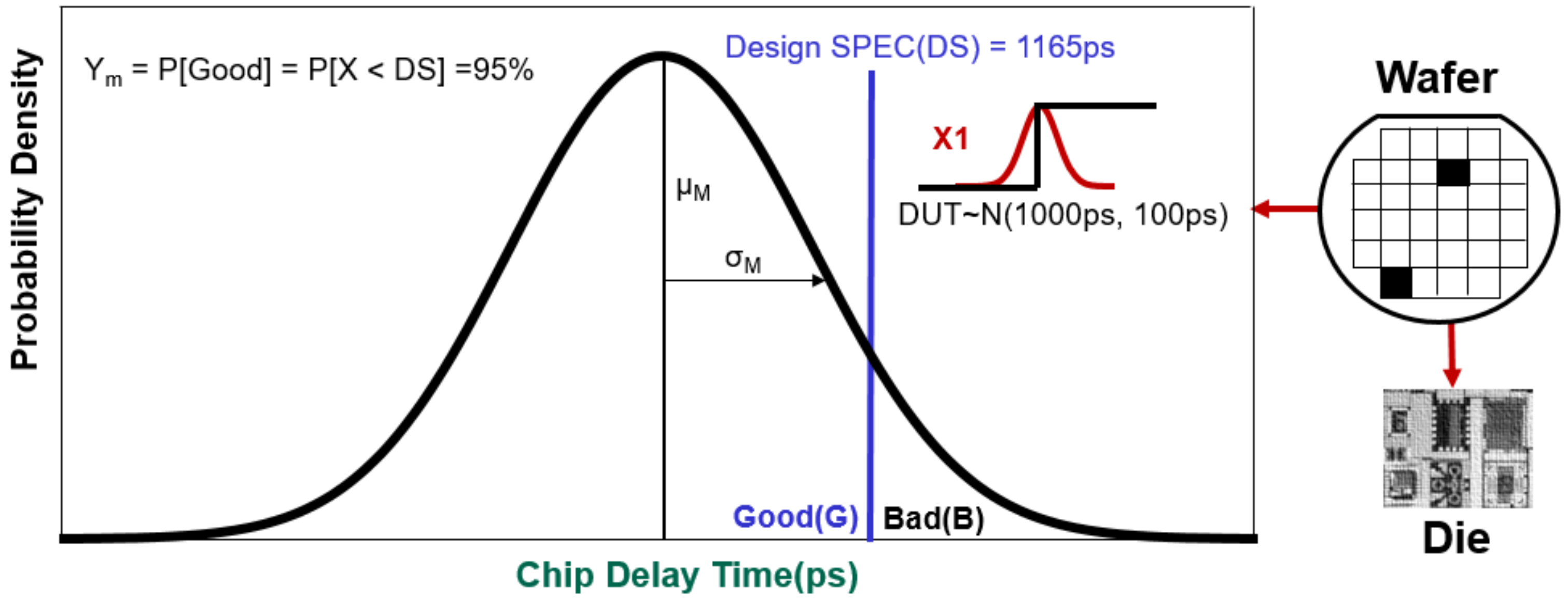

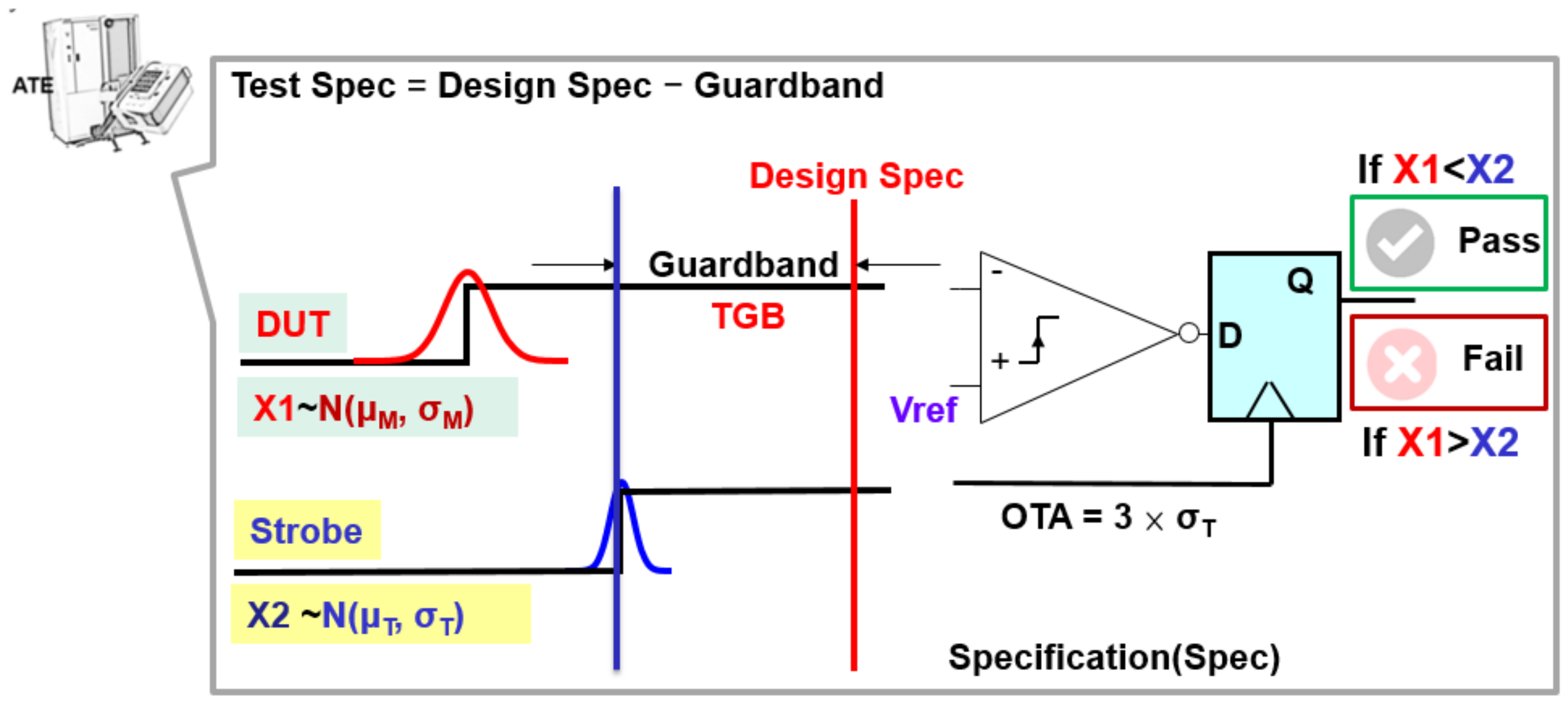

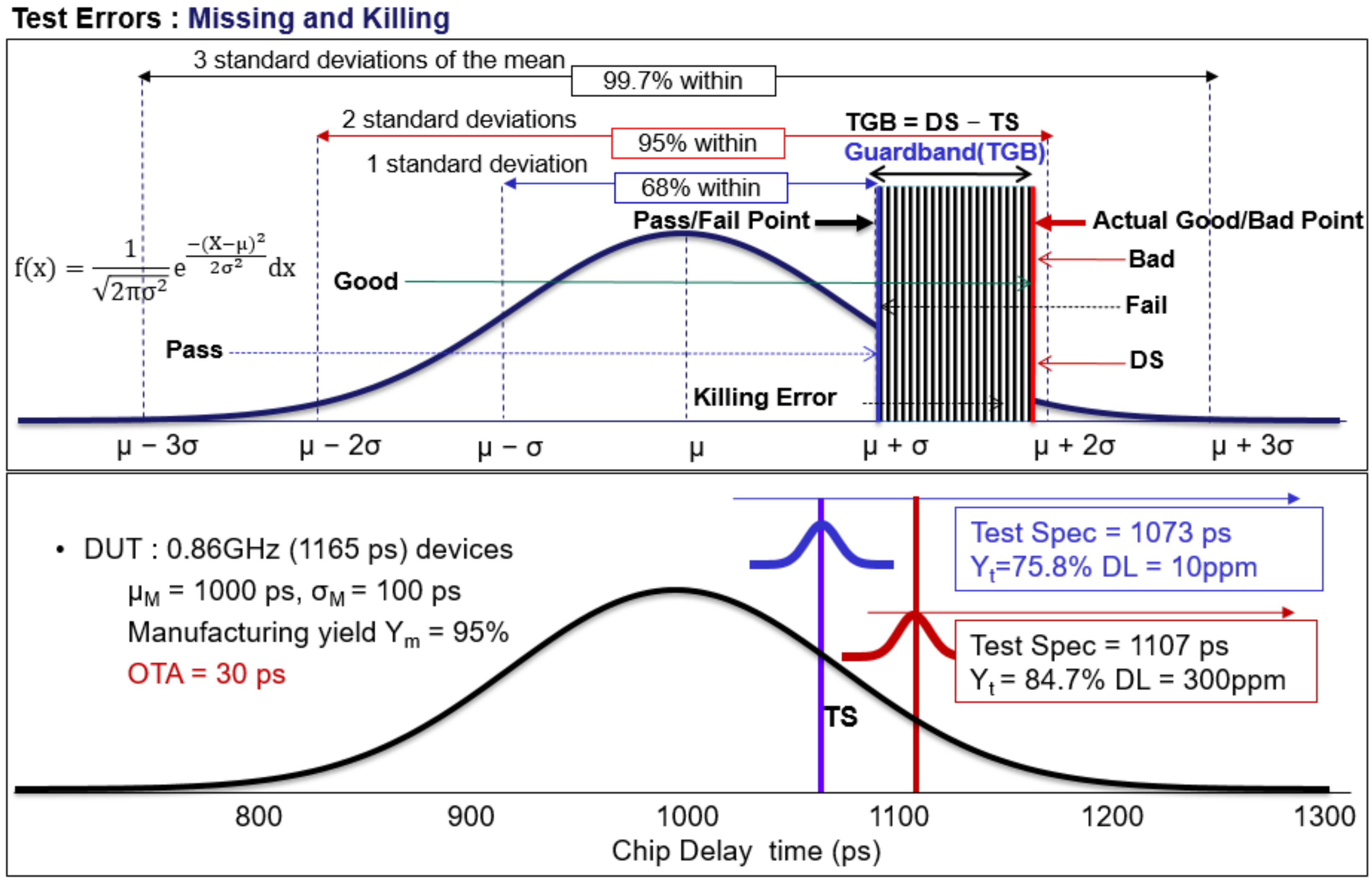
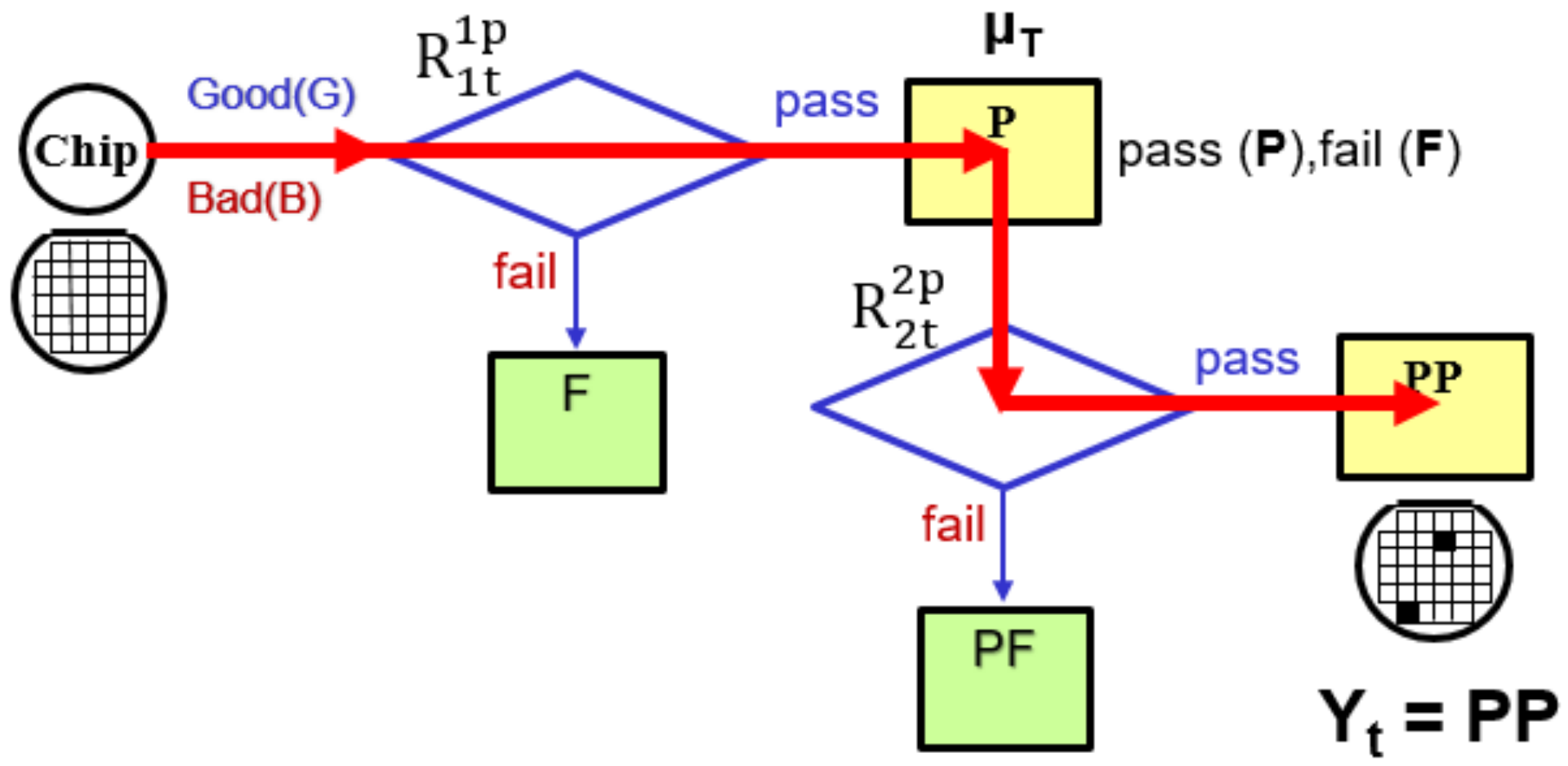

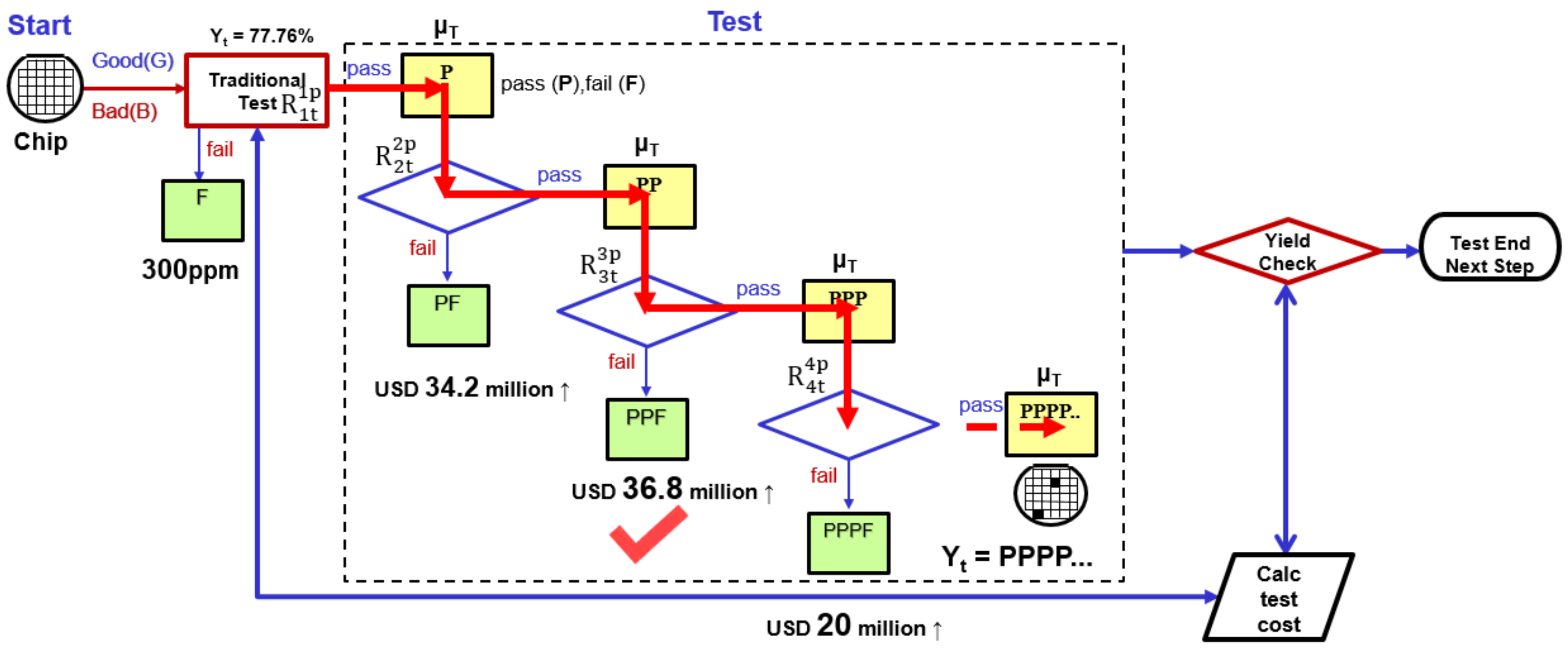
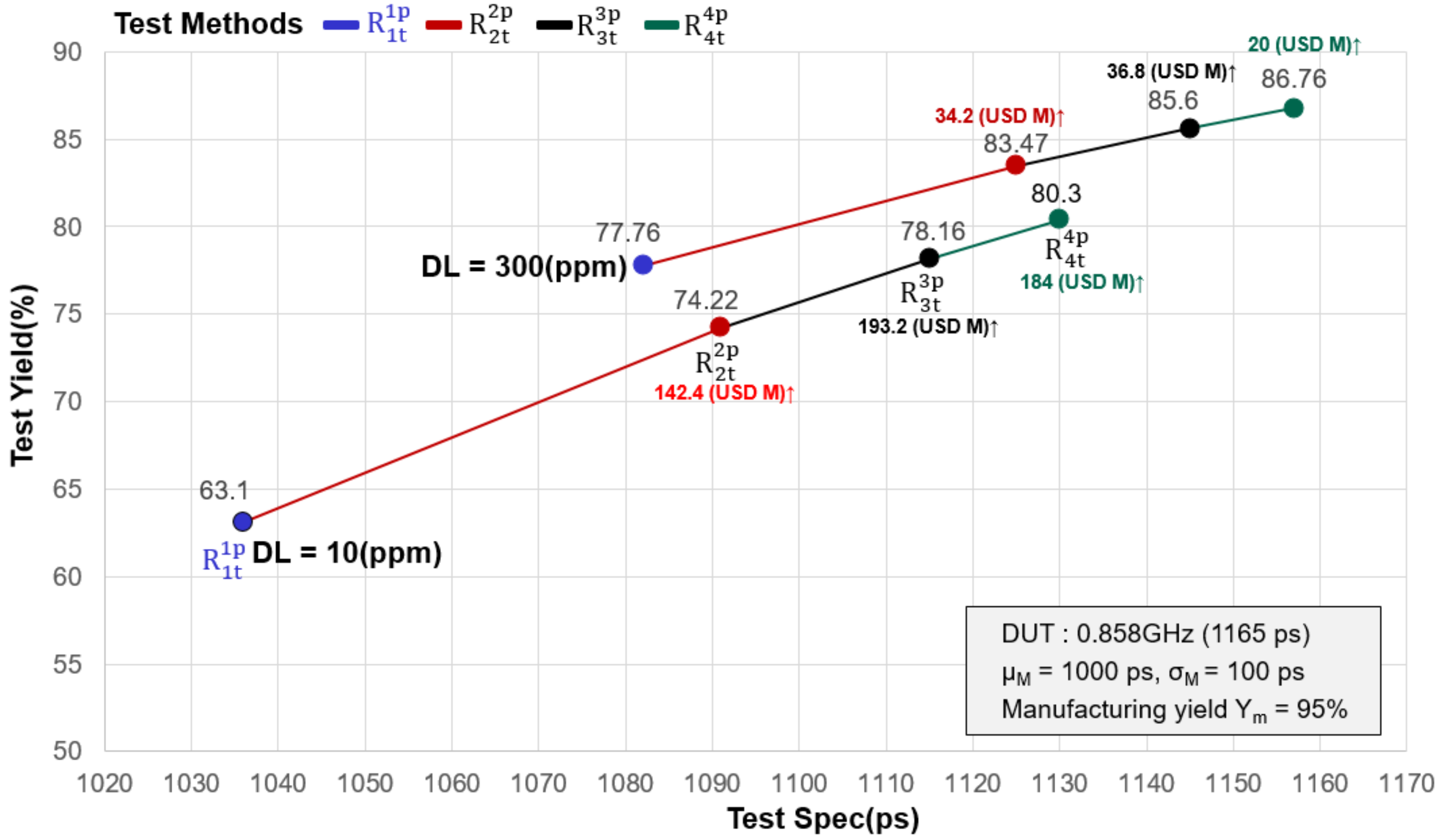

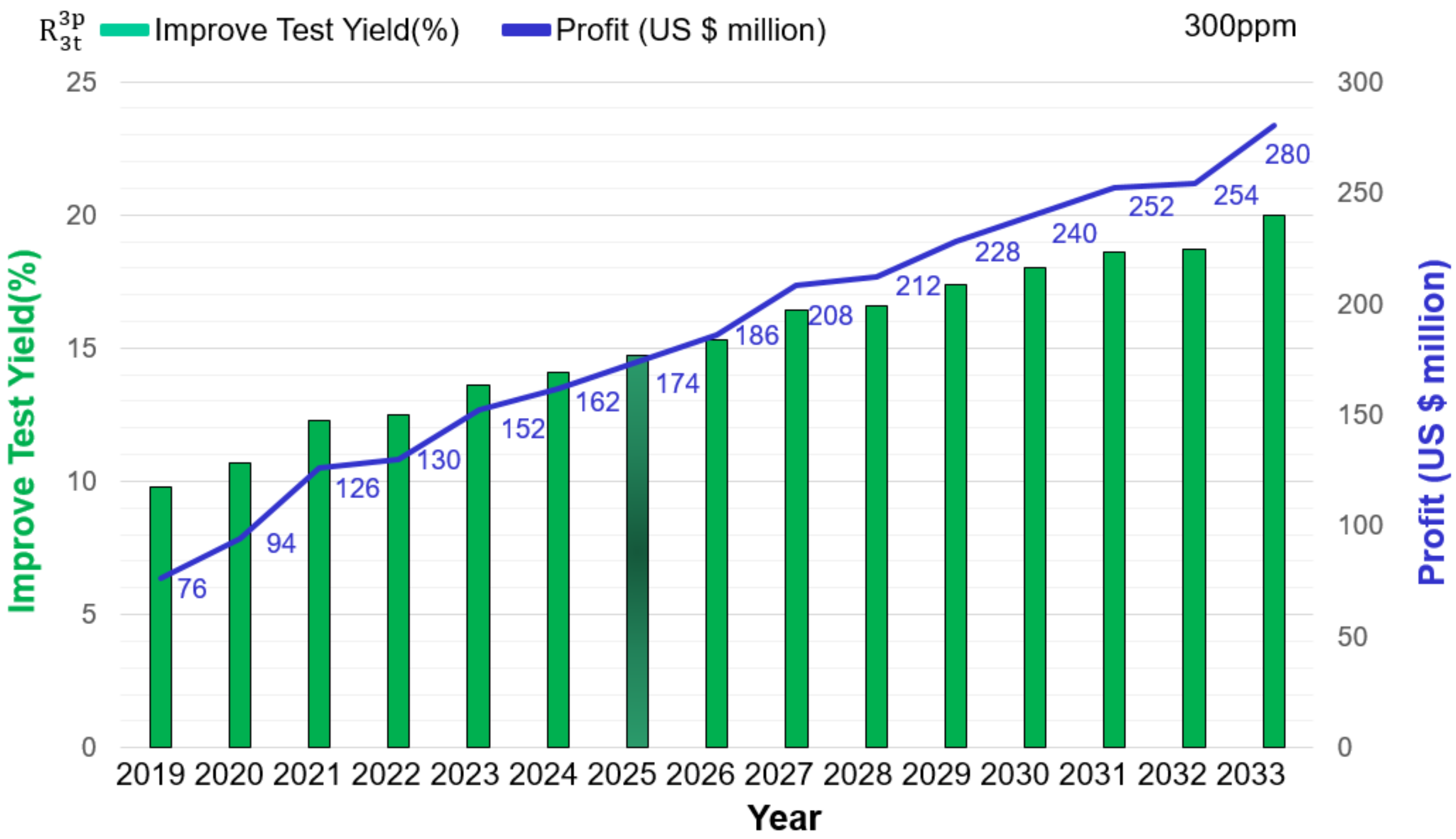
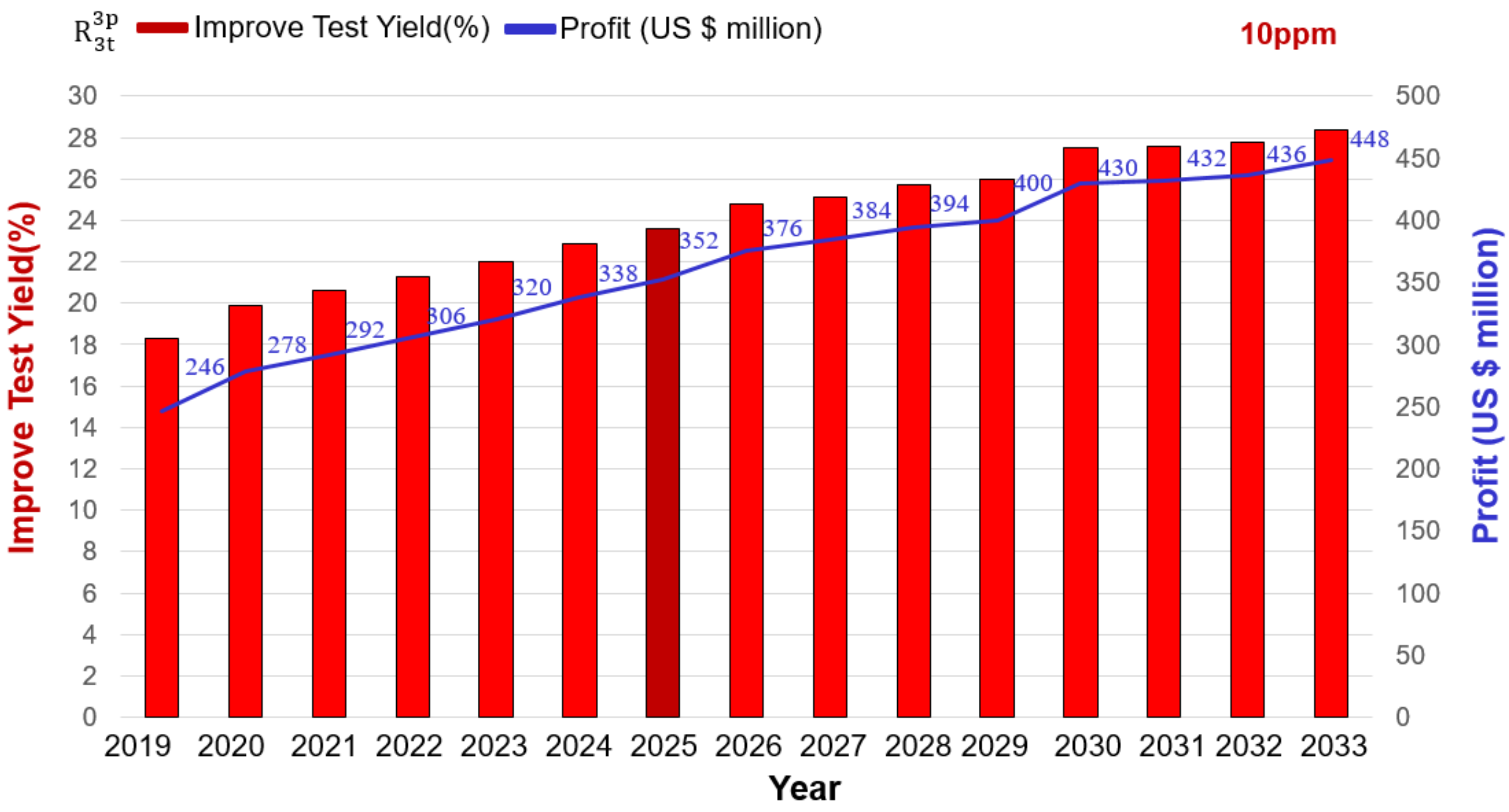
| Chip Frequency | GHz | 0.858 | 0.858 | 0.858 | 0.858 | 0.858 | 0.858 | 0.858 | 0.858 | 0.858 | 0.858 |
|---|---|---|---|---|---|---|---|---|---|---|---|
| Device period | ps | 1165 | 1165 | 1165 | 1165 | 1165 | 1165 | 1165 | 1165 | 1165 | 1165 |
| μM | ps | 1000 | 1000 | 1000 | 1000 | 1000 | 1000 | 1000 | 1000 | 1000 | 1000 |
| σM | ps | 100 | 100 | 100 | 100 | 100 | 100 | 100 | 100 | 100 | 100 |
| OTA = 3σT | ps | 300 | 270 | 240 | 210 | 180 | 150 | 120 | 90 | 60 | 30 |
| σT | ps | 100 | 90 | 80 | 70 | 60 | 50 | 40 | 30 | 20 | 10 |
| r = OTA/3σM | 1 | 0.9 | 0.8 | 0.7 | 0.6 | 0.5 | 0.4 | 0.3 | 0.2 | 0.1 | |
| Test method | |||||||||||
| Ym | % | 95 | 95 | 95 | 95 | 95 | 95 | 95 | 95 | 95 | 95 |
| DL | ppm | 300 | 300 | 300 | 300 | 300 | 300 | 300 | 300 | 300 | 300 |
| TS(μT) | ps | 894 | 931 | 966 | 998 | 1028 | 1056 | 1082 | 1107 | 1127 | 1150 |
| Yt | % | 22.7 | 30.4 | 39.5 | 49.3 | 59.5 | 69.2 | 77.7 | 84.7 | 89.7 | 92.2 |
| DL | ppm | 10 | 10 | 10 | 10 | 10 | 10 | 10 | 10 | 10 | 10 |
| TS(μT) | ps | 762 | 818 | 870 | 917 | 960 | 1000 | 1037 | 1073 | 1106 | 1138 |
| Yt | % | 4.6 | 8.8 | 15.5 | 24.8 | 36.6 | 50 | 63.4 | 75.8 | 85.1 | 91.5 |
| Chip Frequency | GHz | 0.858 | 0.858 | 0.858 | 0.858 | 0.858 | 0.858 | 0.858 | 0.858 |
|---|---|---|---|---|---|---|---|---|---|
| Device period | ps | 1165 | 1165 | 1165 | 1165 | 1165 | 1165 | 1165 | 1165 |
| μM | ps | 1000 | 1000 | 1000 | 1000 | 1000 | 1000 | 1000 | 1000 |
| σM | ps | 100 | 100 | 100 | 100 | 100 | 100 | 100 | 100 |
| σT | ps | 40 | 40 | 40 | 40 | 40 | 40 | 40 | 40 |
| OTA = 3σT | ps | 120 | 120 | 120 | 120 | 120 | 120 | 120 | 120 |
| r = OTA/3σM | 0.4 | 0.4 | 0.4 | 0.4 | 0.4 | 0.4 | 0.4 | 0.4 | |
| Test method | |||||||||
| DL | ppm | 300 | 300 | 300 | 300 | 10 | 10 | 10 | 10 |
| TS(μT) | ps | 77.76 | 83.47 | 85.60 | 86.76 | 63.10 | 74.22 | 78.16 | 80.3 |
| Yt | % | 1082 | 1125 | 1145 | 1157 | 1036 | 1091 | 1115 | 1130 |
| Improve Yt | % | 5.71 | 7.84 | 9 | 11.12 | 15.66 | 17.2 | ||
| Increased maximum profit | million US | 34.2↑ | 36.8↑ | 20↑ | 142.4↑ | 193.2↑ | 184↑ |
| Year | Unit | 2019 | 2020 | 2021 | 2022 | 2023 | 2024 | 2025 | 2026 | 2027 | 2028 | 2029 | 2030 | 2031 | 2032 | 2033 | |
|---|---|---|---|---|---|---|---|---|---|---|---|---|---|---|---|---|---|
| Chip frequency | GHz | 3.00 | 3.10 | 3.20 | 3.30 | 3.40 | 3.50 | 3.60 | 3.70 | 3.80 | 3.90 | 4.00 | 4.10 | 4.20 | 4.30 | 4.40 | |
| Device period | ps | 333 | 322 | 313 | 303 | 294 | 286 | 278 | 270 | 263 | 256 | 250 | 244 | 238 | 233 | 227 | |
| μM | ps | 212 | 208 | 202 | 195 | 190 | 185 | 179 | 174 | 170 | 165 | 161 | 157 | 154 | 150 | 146 | |
| σM | ps | 72 | 69 | 67 | 65 | 63 | 62 | 60 | 58 | 57 | 55 | 54 | 52 | 51 | 50 | 49 | |
| OTA | ps | 100 | 100 | 100 | 100 | 100 | 100 | 100 | 100 | 100 | 100 | 100 | 100 | 100 | 100 | 100 | |
| DL | ppm | 300 | 300 | 300 | 300 | 300 | 300 | 300 | 300 | 300 | 300 | 300 | 300 | 300 | 300 | 300 | |
| Yt | % | 73.9 | 70.8 | 69.4 | 68.4 | 66.3 | 64.4 | 63.6 | 62.3 | 60.2 | 59.2 | 57.5 | 56.4 | 53.9 | 53.3 | 51.3 | |
| TS(μT) | ps | 263 | 250 | 240 | 230 | 220 | 211 | 203 | 195 | 187 | 180 | 173 | 167 | 160 | 155 | 148 | |
| Yt | % | 83.7 | 81.5 | 81.7 | 80.9 | 79.9 | 78.5 | 78.3 | 77.6 | 76 | 75.8 | 74.9 | 74.4 | 72.5 | 72.2 | 71.3 | |
| TS(μT) | ps | 315 | 303 | 295 | 284 | 275 | 266 | 258 | 250 | 242 | 235 | 229 | 223 | 216 | 211 | 205 | |
| Improve Yt | % | 9.8 | 10.7 | 12.3 | 12.5 | 13.6 | 14.1 | 14.7 | 15.3 | 16.4 | 16.6 | 17.4 | 18 | 18.6 | 18.7 | 20 | |
| Increased maximum profit | million US | 76 | 94 | 126 | 130 | 152 | 162 | 174 | 186 | 208 | 212 | 228 | 240 | 252 | 254 | 280 | |
| DL | ppm | 10 | 10 | 10 | 10 | 10 | 10 | 10 | 10 | 10 | 10 | 10 | 10 | 10 | 10 | 10 | |
| Yt | % | 56.5 | 52.1 | 50.5 | 48.9 | 46.1 | 43.8 | 42.5 | 40 | 37.5 | 36 | 34.1 | 32.5 | 29.4 | 28.6 | 26.6 | |
| TS(μT) | ps | 225 | 212 | 203 | 193 | 183 | 174 | 166 | 157 | 149 | 142 | 135 | 129 | 121 | 116 | 109 | |
| Yt | % | 74.8 | 72 | 71.1 | 70.2 | 68.1 | 66.7 | 66.1 | 64.8 | 62.6 | 61.7 | 60.1 | 60 | 57 | 56.4 | 55 | |
| TS(μT) | ps | 291 | 279 | 270 | 260 | 250 | 242 | 234 | 226 | 218 | 211 | 205 | 199 | 192 | 187 | 181 | |
| Improve Yt | % | 18.3 | 19.9 | 20.6 | 21.3 | 22 | 22.9 | 23.6 | 24.8 | 25.1 | 25.7 | 26 | 27.5 | 27.6 | 27.8 | 28.4 | |
| Increased maximum profit | million US | 246 | 278 | 292 | 306 | 320 | 338 | 352 | 376 | 384 | 394 | 400 | 430 | 432 | 436 | 448 | |
Publisher’s Note: MDPI stays neutral with regard to jurisdictional claims in published maps and institutional affiliations. |
© 2022 by the authors. Licensee MDPI, Basel, Switzerland. This article is an open access article distributed under the terms and conditions of the Creative Commons Attribution (CC BY) license (https://creativecommons.org/licenses/by/4.0/).
Share and Cite
Yeh, C.-H.; Chen, J.-E. Application of Three-Repetition Tests Scheme to Improve Integrated Circuits Test Quality to Near-Zero Defect. Sensors 2022, 22, 4158. https://doi.org/10.3390/s22114158
Yeh C-H, Chen J-E. Application of Three-Repetition Tests Scheme to Improve Integrated Circuits Test Quality to Near-Zero Defect. Sensors. 2022; 22(11):4158. https://doi.org/10.3390/s22114158
Chicago/Turabian StyleYeh, Chung-Huang, and Jwu-E Chen. 2022. "Application of Three-Repetition Tests Scheme to Improve Integrated Circuits Test Quality to Near-Zero Defect" Sensors 22, no. 11: 4158. https://doi.org/10.3390/s22114158







